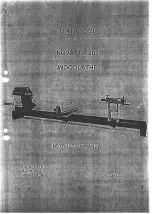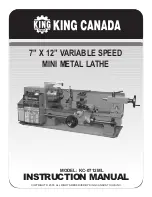
bevel side down, keep the base of the bevel
against the work. Good practice is to place the
skew well over the work, pull it back until the
edge begins to cut, then swing the handle into
position to advance the cut. Both the toe and
the heel of the skew can be used for taking
light cuts, but do not penetrate the wood too
deeply without cutting clearances, as there is
danger of burning the tip of the tool.
5.
USING THE PARTING TOOL
The parting tool has just one primary purpose to
cut straight into the workpiece as deep as
The spear point is used for fine scraping and
delicate operations, such as the forming of
beads, parallel grooves and shallow vees. Edges
and bowl contours can be rounded with the
round nose chisel. Any flat surface can be
scraped with the flat nose chisel.
7.
USING SHAPER OR MOULDING KNIVES
desired, or all the way through to make a cut-
off, it is therefore a very narrow tool. 1/8 inch
wide and shaped to cut its own clearance so
that the edge will not be burned. When used
for scraping, however, it should be backed off
regularly to prevent overheating.
Unlike the gouge and skew, the parting tool is
seldom held with the bevel against the work.
As the amount of stock removed is small, a
support for the bevel is not necessary. The tool
is simply fed into the work at an angle (for
cutting), or pointed at the workpiece centre (for
scraping) it can be held easily in one hand.
6.
USING THE SCRAPING CHISELS
A 1/2” wide spear point chisel, a 1/2” wide round
nose chisel and a 1” wide flat nose chisel
complete the list of tools ordinarily used by home
craftsmen. Each of these scraping chisels can
be purchased in various other sizes for special
purposes. All are very useful for diameter
scraping operations and for circumference
scraping, when cutting methods cannot be
employed.
An old chisel can be made to serve as a holder
for ‘shaper’ or ‘moulding’ knives. Such knives
make it possible to scrape many interesting
shapes in the workpiece surface in one or two
operations instead of the many operations
required with standard chisels. It is generally not
practical to use cutting methods with special
shape tools, scraping methods should be used.
The holder should provide a shoulder against
which the butt end of the knife can be firmly
seated, and the knife must be securely
mounted, either by means of a screw threaded
into the holder, or be compressing it between
two prongs bolted together.
8.
USING A BLOCK PLANE
Clear glass smooth finishes (especially on soft
woods) can be obtained by using a block plane
set to take a fine shaving. The tool rest should
be raised up approximately to the top of the
workpiece, and the plane should be horizontal,
but turned slightly in the direction of travel so
that it will take a shearing cut. Two tool rests,
one in front and the other behind the work, can
be used to advantage in positioning the plane
so as to exactly limit the depth of cut (and
finished size of the workpiece).
21
Fig. 29
Fig. 31
Fig. 30
Fig. 28




































